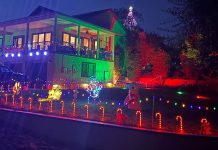It was July 4, 1826, and throughout every American village and
city, the people were celebrating the 50th anniversary of the
adoption of the Declaration of Independence.
It was July 4, 1826, and throughout every American village and city, the people were celebrating the 50th anniversary of the adoption of the Declaration of Independence.
Parades, many led by veterans of the Revolutionary War marching stoutly despite their age, speeches, picnics and fireworks were the order of the day. Even some outposts in distant Wyoming and Colorado celebrated with mountain men vying against each other in sharp-shooting contests and whiskey drinking while Indians watched mutely.
Near Pittsburgh, the already large Foster family celebrated the addition of another son, Stephen Collins Foster, who would become known as America’s troubadour to the next generation of his countrymen.
Braintree, Mass., also celebrated but one neighborhood was exceptionally quiet. People who passed an imposing house lifted their hats or curtsied in respect to the old gentleman who resided in it, said to be in his final illness.
Upstairs, the afternoon passed slowly to the measured ticking of the large clock in the corner. From time to time, the doctor who sat beside the bed of John Adams, a signer of the Declaration and the second president of the United States, leaned forward and took the pulse of the dying man.
Adams had earned many honors since his birth 90 years earlier. His parents had sent him to Harvard, even though they had little schooling, and the student had learned his lessons well. He became an attorney and aroused the ire of neighbors when he defended the British soldiers who had taken part in the Boston Massacre, in the belief that any one accused of a crime should have a proper defense.
As the winds of revolution blew across the 13 colonies, he represented Massachusetts in the Continental Congress. With Thomas Jefferson, he worked on the great Declaration. After the colonies won independence from Great Britain, he was George Washington’s vice president in the formation of a new government.
He succeeded Washington as president, with Jefferson as his vice president, and was the first inhabitant of the Executive Mansion when the paint on the walls was still wet. When Adams tried for a second term, Jefferson defeated him.
But the end of public office did not mean the end of his service to his country. He took an avid interest in the affairs of the United States and counseled many of its leaders. One such, his son, John Quincy Adams, was even now presiding over the 50th anniversary in the White House as president of the United States.
Adams had ended a long feud with Jefferson, and their correspondence over many years remains as a testament to how those two great leaders saw the place of their county in the world’s history.
From time to time, Adams turned and muttered on his deathbed. We cannot know all of his thoughts on the last day of his life – from his childhood to a mover of great affairs on the world stage – but we are sure of one.
Adams turned again and slightly raised himself, and the doctor leaned forward to catch his last words, “Well, Tom Jefferson survives me,” before he sank back and closed his eyes for the final time.
It would have given him no satisfaction to know that a few hours earlier and hundreds of miles away in Virginia that Thomas Jefferson, his one-time foe and old friend of many years, had died.
Herman Wrede is a Free Lance correspondent. His column appears every Friday.









